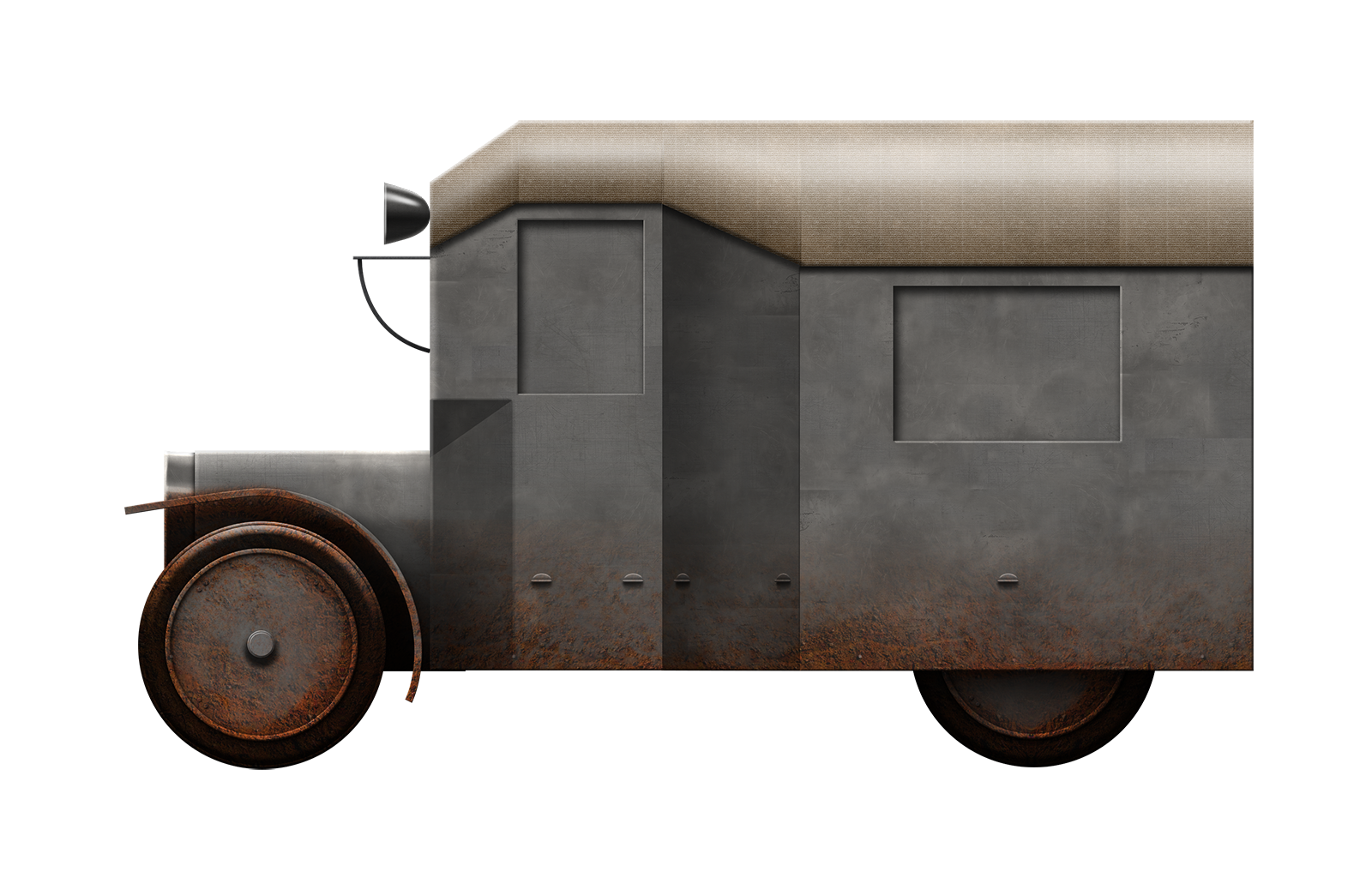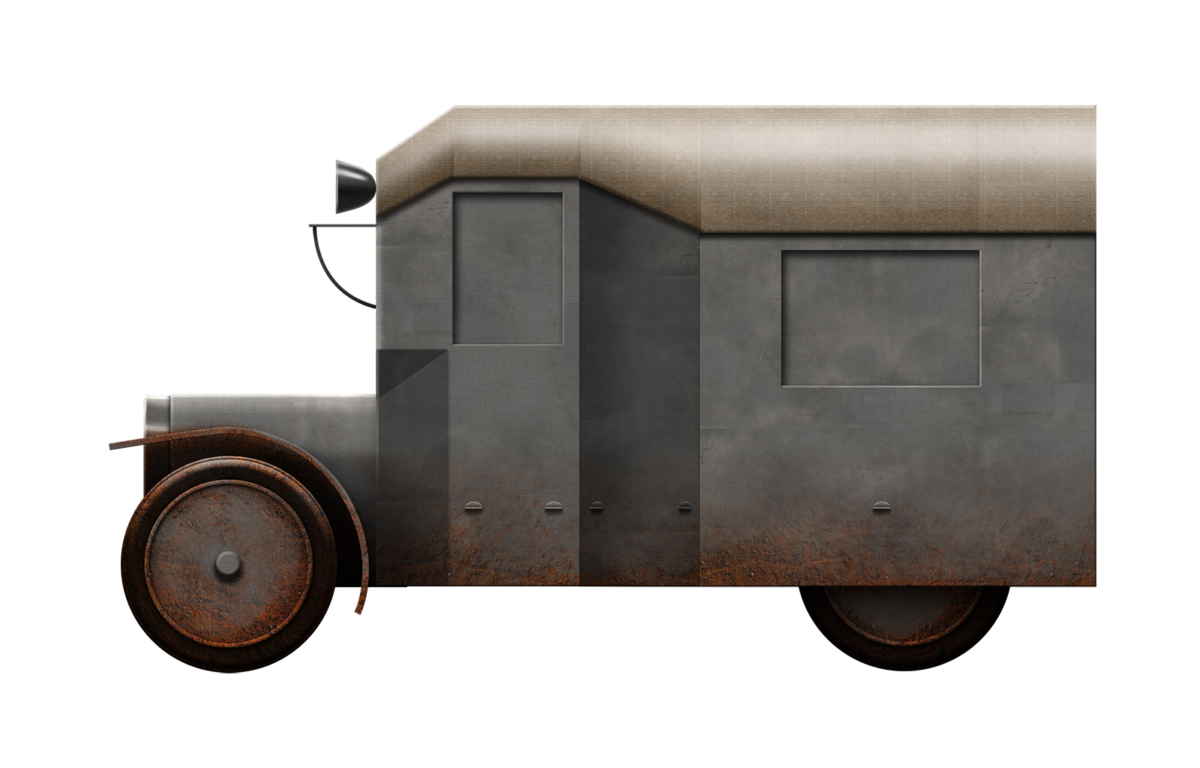 German Empire (1908-1909)
German Empire (1908-1909)
Armored Car – 1 Prototype Built
As is the case with many early armored vehicles, the armored Daimler from 1909 is not widely known and has received only scant attention in publications. Just one vehicle was built, possibly as early as 1908, and it was used during maneuvers in 1909 alongside other vehicles with the aim of understanding the value of armored cars for the army. As the results were deemed to be negative, the German War Ministry abandoned the armored car as a viable concept and the Daimler 1909 disappeared from records.

Background
Unfortunately, most records of German armored cars made before 1918 were lost during the Second World War. Therefore, research is mostly limited to contemporary news reports, few secondary sources, and observation of the only known photograph. However, it is not uncommon that these contradict each other. Despite this, some information is still preserved and warrants an analysis.
It is possible that production of the armored vehicle had already begun in 1908. In the military magazine ‘Mitteilungen über Gegenstände des Artillerie- und Geniewesens’ from early 1908, it is mentioned that:
“An armored car was accepted by the Saxon Army Administration in Remscheid. It is equipped with a machine gun and the armor gives such protection that, even in close quarters combat, it provides complete protection for the crew.”
It is striking that the supposed 1909 model was also armored in the city of Remscheid. Furthermore, in the French ‘Journal des sciences militaires’ of November 1908, it is noted that if tests were successful, they would be taken into service as reconnaissance vehicles with Saxon regiments. Another mention comes from the Streffleurs militärische Zeitschrift from June 1909 which states that:
“in addition to the armored car of the Rheinischen Metallwaren- und Maschinenfabrik [Ehrhardt BAK, red.], which has been tested since 1907, another such vehicle was built in 1908 by the Versuchsabteilung of the Verkehrstruppen in Berlin and armored in Remscheid.”
An argument can be made against this position as well. A short notice in the Allgemeine Sport-Zeitung of 17th January 1909 mentions that an armored car was under construction for the Testing Unit of the German Mobile Troops (Verkehrstruppen) to be used during the autumn maneuvers. However, that does not necessarily disprove the theory, as it is possible that production started in 1908 and was still underway by early 1909. This is further strengthened by a mention from April 1909 that, in that month, an armored car was taken over by the Saxon Army Command.
Name of the Daimler 1909 Model
It appears that the vehicle never received an official name. It is generally referred to as an armored Daimler or Mercedes chassis. Since 1902, all sport and tour cars of the Daimler company were advertised as Mercedes, so naming it either Daimler or Mercedes is both correct. Walter J. Spielberger called it a 45-PS-Mercedes-Wagen, while Heinrich Kaufhold-Roll named it Mercedes-Panzer-Maschinengewehr-Wagen. Rainer Strasheim gave no name and referred to it as a “makeshift armored car, based on a 40 hp Daimler chassis”.


Design
The vehicle was assembled in the city of Remscheid. A contemporary source mentions the Stahlwagenfabrik (Steel car plant), referring to the Bergische Stahl-Industrie. This factory did produce steel chassis for railway cars and thus had the right tools to be able to produce an armored vehicle.
The vehicle was based upon a commercial Daimler chassis, also known as Mercedes, but the specific model is unknown. It is also unclear how much horsepower the Daimler petrol engine provided, as figures are given of either 35, 40, or 45 horsepower. The spoked wheels, protected by steel discs, were shod with pneumatic tires and suspended by leaf springs.
In terms of external appearance, the vehicle showed similarities with the French CGV 1905 and seems to have been partially modeled after it. The front radiator was unarmored which allowed sufficient cooling of the engine, but also made it very vulnerable to enemy fire. The crew compartment was located behind the engine. The driver could see through a large hatch in the front, which could be folded up or down. Another large opening was located on the right side of the car. The presence of a similar opening on the left side is possible but not visible on the photograph. Behind the driver was a large open-topped crew compartment. Again similar to the CGV, large closable hatches were located on each side. It is unknown what the rear looked like. The car was open-topped but, in the single known photograph, a tarpaulin is fitted to protect against rain. According to the French Journal des sciences militaires, there was space in the vehicle for ten people, including a driver.
Spielberger claims that the vehicle was armored with 3.5 mm thick plates. This would have been totally inadequate to provide reliable protection against infantry weapons fire, especially from close range. This was made worse by the large hatches that were easy to fire through once opened and the pneumatic tires that could easily be damaged by enemy fire.
The car carried one 7,92 mm machine gun, but it is unknown how this weapon was deployed, either on a pivot extending above the vehicle or through the hatches in the sides. It is also unknown what kind of machine gun was carried. At the time, the German Army used a quantity of the Maxim-derived MG 99 and MG 01, while an improved model, the MG 08, was just taken into production. Either of those was used.
The Maneuvers
Plans had been made to comparatively test four vehicles during the 1909 autumn maneuvers performed by the 5. Garde-Infanterie-Brigade (5th Guards Infantry Brigade) in eastern Brandenburg. Among these vehicles were two Charron Girardot Voigt 1905 models acquired from France and originally destined for Russia. They were in use by the Kraftfahrabteilung (Motor Vehicle Department) and, over time, several improvements had been made. The third vehicle was an unarmored Büssing omnibus chassis with a simple flatbed and equipped with two machine guns. The last was the Daimler/Mercedes armored car. Even before the maneuvers, it was thought that the Büssing would perform the best, since it was the lightest.

Negative Results
The maneuvers yielded mixed conclusions with the observers. The mobility and fast maneuver speed of the vehicles on roads in good condition was appreciated, but at the same time, the very limited off-road capabilities were criticized. The Versuchsabteilung (Testing Department) recommended further testing. Using the test results, the department submitted a list of specifications, to which a successful armored car had to conform, to the War Ministry. It concluded that the armor had to be bulletproof against infantry weapons, the crew should be able to fire in any direction, cars should be equipped with solid rubber tires instead of pneumatic tires, and have a suspension that allowed for off-road driving.
However, on 12th March 1910, after a request of the General Inspection of the Military Transport Department, the War Ministry decided that all further tests with armored vehicles were to be suspended. They concluded that “Armored cars can have a military value in certain cases, such as border protection, being used as blockades in mountainous areas, or blowing up bridges over rivers, but otherwise, their usefulness in war is very limited.” This verdict was further enhanced by the high operation costs in peacetime and their inability to drive off-road, although the mobility on-road was appreciated. As a result, the development of new armored cars was suspended by the Infantry Department (A2) of the War Ministry.
Furthermore, near the end of 1911, the General Inspection of the Military Transport Department reached the conclusion that armored cars were technically too fragile and vulnerable, the engines were unreliable, and adequate armor would render the cars too immobile in battle and reduce the mobility when under enemy fire, making the vehicles easy targets for artillery and field guns. At the same time, a lightly armored car would be too vulnerable to regular infantry fire. An annual report from 1911 summarized: “The age of armor is over, as the weight affects speed, without providing real protection against fire.” Thereupon, the available armored cars were supposed to be sold off.
Fate of the Daimler
Presumably, all four vehicles were scrapped after being sold or at least stripped from their armor, although there may be a small possibility that the CGVs were used in 1914. According to Kaufhold-Roll, the Daimler vehicle would become the precursor to the Daimler-Motoren-Gesellschaft Maschinengewehrträger from 1913. This was an unarmored machine gun carrier designed in 1913 and two examples were constructed in 1914.

Conclusion
Although an elaborate assessment of the vehicle cannot be made with the limited information that is available, the Daimler was clearly not a great vehicle. Having decent mobility, the car lacked off-road capabilities and was poorly protected. The maneuvers of 1909 provided valuable information regarding what an armored car had to be capable of. However, instead of further investigating the concept and resolving the observed problems, it was decided that the armored car had been an interesting curiosity but its age was over. Little did the writers of these reports know that the armored age was just beginning.

Specifications |
|
| Crew | 10? (driver, attendant, troops) |
| Propulsion | Daimler, petrol, 35-45 hp |
| Armor | 3.5 mm |
| Armament | non-fixed machine gun, personal firearms |
| Total production | 1 |
Sources
Streffleurs Militärische Zeitschrift, Automobilwesen, 7th December 1909, p.1629-1630.
Streffleurs Militärische Zeitschrift, Kriegstechnik, 1st June 1909, p.515.
Mitteilungen über Gegenstände des Artillerie- und Geniewesens, Deutschland, 1st Issue, volume 59, 1908, p.40.
Wehr und Waffen 1914-1918, Ernst von Wrisberg, Koehler, 1922, p.159.
Allgemeine Automobil Zeitung, Panzerautomobile bei den deutschen Manövern, 22nd August 1909, p.9.
Allgemeine Sport-Zeitung, Notizen. Ein Panzerautomobil, 17th January 1909, p.69.
Journal des sciences militaires, 3 La voiture des ateliers Remscheid, 1st November 1908, p.170.
Het Bloemendaalsch Weekblad, De automobiel in verschillende legers, 17th April 1909, p.5. NHA.
Die deutschen Radpanzer im Ersten Weltkrieg, Heinrich Kaufhold-Roll, Biblio Verlag, 1996.
Panzer-Kraftwagen: Armoured Cars of the German Army and Freikorps, Tankograd 1007, Rainer Strasheim, Verlag Jochen Vollert, 2013.
Die gepanzerte Radfahrzeuge des deutschen Heeres 1905-1945, Walter J. Spielberger, Hilary L. Doyle, Motorbuch Verlag, 2002.
Various sources have been accessed via https://digitalniknihovna.cz, https://anno.onb.ac.at/, and https://gallica.bnf.fr.


3 replies on “Panzerautomobil Daimler 1909”
It looks like a sideways fridge on wheels
How where the real wheels meant to be changed with the superstructure half covering them?
Hi,
It is hard to discern from the photograph, but it appears the lower armored plates could be removed separately. Indeed this would have been a flaw, it’s much easier to have a cutout for the wheel or a separate armored plate on hinges.
That said, this vehicle was mostly a proof of concept, rather than a refined thought-out design, so it is probably an issue that got noted down too.
Kind regards, Leander